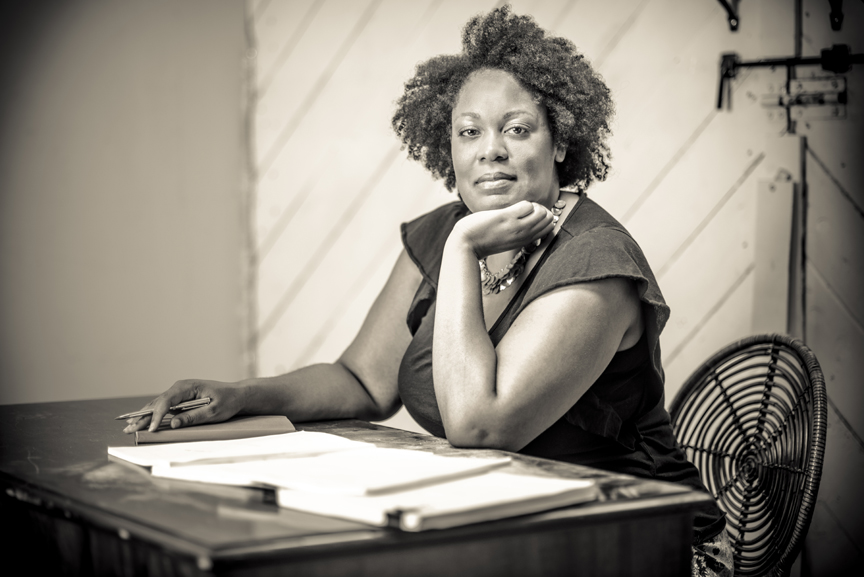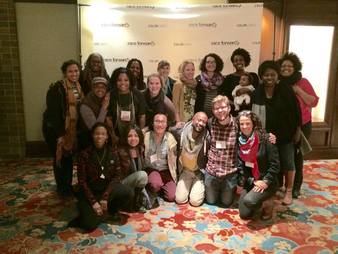 Our incredible team of Dance Exchange artists, collaborators, and partners. Our incredible team of Dance Exchange artists, collaborators, and partners. It’s important to note that the 2014 Facing Race conferences was the largest one by far and was the first one to be held in the South. Day Two offered just as many wonderful choices if not more! The opening plenary examined the powerful impact of southern organizing and the closing key note call to actions from three outstanding speakers. My break sessions explored racial equity in the education system and the representation of race in the media. What follows are my notes from each session: Roots and Wings: Southern Histories, Legacies and Innovations for the Future Description: When some outside the region think of the US South, often the imagination leads to images of slavery, struggle and protest that starts in the 1800s and stops in the 1960s. For the many of us- people of color, immigrants communities, LGBTQ people – who populate and call this region home, we experience and understand “the South” as not only the place where race, power, and revolution is best understood but also where history and legacies give way to 21st century innovation for our movements. Click here to learn more about the session and speakers. Having been raised in Texas and in the process of moving to North Carolina, I was particularly interested in this conversation. Here are my notes:
Transformative Approaches for Addressing Race, Healing and Taking Action for Equity in Schools Description: This interactive session will explore key racial equity concepts and strategies that support an educator’s ability to identify, interrupt and address inequity in their classrooms and schools. Educators will walk away with a deeper understanding and practical tools for engaging in sense-making conversations about racial equity that lead to productive action. Click here to learn more about the session and speakers. Goals for the Session:
Leading for Racial Equity Requires:
Listening: Your Best Leadership Tool Any kind of transformation begins with how you listen and what kind of discourse that you’re in. Constructivist Listening allows for such transformation. Guidelines
Talking about Race and Racism in schools provides students, educators, and families with an understanding, awareness, and vision of Racial Equity and Justice. We have to remember that school systems are based in hegemonic patriarchal structures. We have to ask ourselves:
We must remember that when racial inequity is present, we much change the discourse. We moved from (Discourse 1) dominant ways of seeing and engaging the work of education that maintain existing practices and serve to reproduce social inequity. From here, we move to (Discourse 2) new ways of seeing and engaging the work that challenge the status quo by naming uncomfortable realities and unequal conditions while pushing for the deep inquiry. We want to apply tools constructively listen to shift the discourse and create spaces for learning and change. Remember, it’s not enough to stop the bias. We must create a space for something different. This was by far, the most useful session of the entire conference. Olivia Pope Notwithstanding: Strategies to Transform a TV Landscape Causing Everyday Harm to Black People Description: Stereotypical images of Black people are not only insulting and inaccurate — they’re dangerous. Research shows that the limited stories we see shape cultural attitudes about Black people and drive the decisions of lawmakers, employers, teachers and police. Media literacy training has taught us all to understand the problem, but what are the strategies for creating real change? Click here to learn more about the session and speakers. While most directly related to the work I do as a playwright, this session left me and others quite frustrated. Unfortunately, we didn’t discuss action plans or next steps, but here are some poignant thoughts and reflections:
The Next Fifty Description: This year and next we will celebrate the anniversaries of major racial justice victories like the Civil Rights and Voting Rights Acts. In this plenary, big thinkers will reflect on trends and strategies for the next half century. Get your long term on with Ian Haney Lopez, Van Jones, and Rinku Sen. Click here to learn more about the session and the speakers. Ian Haney Lopez spoke to the 2042 demographic shift, the evolution of racism, and the boundaries of whiteness:
Van Jones challenged leaders of color to expand our presence and expertise in the four centers of power: Washington DC, Wall Street, Silicon Valley, and Hollywood.
Rinku Sen delivered another rousing address that marked the next 50 years of our work together and how we have to see ourselves as one constituency.
With that, this amazing conference came to an end. I left feeling exhausted, but armed with resources, methodologies, and passionate allies. I felt a shift occur in my thinking, in how I want to spend my time, effort, and energy. I’m not the same person from all that I’ve experienced over the past four days and I’m grateful for it. I’m excited to take this knowledge and new sense of self back my work in the American Theatre and to my new home in North Carolina.
0 Comments
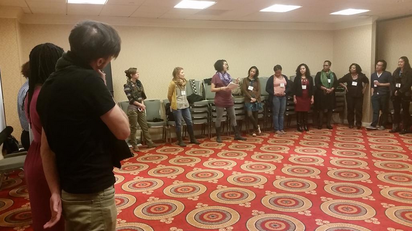 Cassie and Paloma facilitating at the 2014 Facing Race Conference. Photo by Jacqueline Lawton. Cassie and Paloma facilitating at the 2014 Facing Race Conference. Photo by Jacqueline Lawton. One of the most challenging aspects of the conference was deciding upon which breakout session to attend. There were so many wonderful choices! The opening plenary addressed work of youth activists and organizers and the evening key note offered a powerful intergenerational conversation around racial justice and equity. My break sessions offered a meditation on the intersection of race and ethnicity and the role of both the arts and government. What follows are my notes from each session: This is How We Do It: Youth Led Racial Justice Description: A new generation of racial justice leaders are interrupting and innovating in the ways racial justice work is made relevant in our times. In various ways, young people are working creatively, intersectionally and courageously to set our nation on course for the racially just future we deserve. Click here to learn more about the session and speakers. It was excellent way to begin the day by focusing on youth activist and organizers. Their ambition, focus, and ideals were insightful and inspiring. While they are seeking counsel and guidance from elders, they aren’t waiting for adults to step in and intervene on their behalf. Here are the greatest takeaways for me from this panel discussion:
Reclaiming Government: A Dialogue about the Intersection of Race, Ethnicity and the Public Sector’s Role in Advancing Equity Description: The challenges and opportunities of an increasingly diverse America demand that we rebuild broad public support for an active governmental role in creating opportunities and reducing inequities. The implicit and explicit racialization of policies, programs and public systems can not only exacerbate inequities but also influence the public’s perception of and relationship to government. Click here to learn more about the session and speakers. We began the conversation generating a list of questions that we wanted to address. Here are the ones that guided the conversation:
The discussion that followed was as rich and thoughtful. Here are some of the suggestions and observations that stayed with me:
From there, we began to address specific way to be in dialogue with members of the public sector. If someone opposes racial justice or reform police, then convincing them to support it requires several things:
Then, we discussed the careful negotiation of data. Of course, we need to gather data and research to prove our claims and support our initiatives. However, data can drive people away:
It is important to lead with values, contextualize the data with stories or narrative, and know your audience. Here is where stories are so beneficial:
For those working in the arts, I strongly encourage you to visit the Performing Arts Alliance and make use of theirAdvocacy Basics for Performing Arts Organizations. Creative Convening: Moving Racial Equity Forward Through the Arts Description: Dance Exchange breaks boundaries between stage and audience, and theater and community. For 38 years, we have been stretching the range of contemporary dance through bringing ideas into action. We are partnering with Dallas Faces Race to ask how communities can use creative strategies to advance racial equity, in Dallas and beyond. Click here to learn more about the session and speakers. During this session, participants engaged in personal storytelling and dance. They were asked to focus on their personal histories and to examine how these histories informed their decisions on an individual and structural level. While the work didn’t focus specifically on race, participants demonstrated the listening skills, collaboration, and intergenerational work required to undo racism and move towards a more equitable future. Working in pairs, participants were asked to reflect on and share verbal responses to the following prompts:
From there, participants worked in pairs to share stories and make creative responses (sounds, movements, and gestures) to the following prompts:
In closing, participants were asked to meditate on something they would carry forward from this experience and pass on in some way. While there wasn’t time to hear the verbal response, we were able to see pairs dance and it was beautiful work. This breakout session is part of a 2-year engagement that Dance Exchange has with Dallas-based partners. It’ll be exciting to see what develops and what materials are created to pass this work on to others. Keynote Address The keynote speakers for this year’s Facing Race National Conference were Dr. Bernice Johnson Reagon, Toshi Reagon, and Tashawn Reagon. It was a passionate and inspiring conversation that illustrated the significance of art, activism, and the intergenerational work around racial justice and equity. These thoughts and reflections resonated most with me:
We were encouraged us to dig deep and lean into discomfort. We were reminded to engage in work that brings about healing and meets each other with kindness. And however tired we might feel at any given moment on this journey, we who believe in freedom cannot rest until it comes. The room shook with the truth they were speaking. I went to sleep that day feeling a renewed sense of purpose and hope for the work ahead. 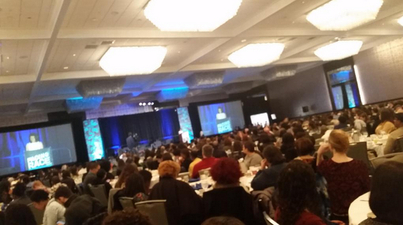 The 2014 Facing Race Opening Ceremony. The 2014 Facing Race Opening Ceremony. In 1964, President Lyndon B. Johnson put pen to paper and signed the Civil Rights Act into law. That same year, Dr. Martin Luther King Jr. was awarded the Nobel Peace Prize for his nonviolent resistance to racial prejudice in America and shared his vision for the future in his speech: “I believe that unarmed truth and unconditional love will have the final word in reality. This is why right temporarily defeated is stronger than evil triumphant. I believe that even amid today’s mortar bursts and whining bullets, there is still hope for a brighter tomorrow. I have the audacity to believe that peoples everywhere can have three meals a day for their bodies, education and culture for their minds, and dignity, equality and freedom for their spirits.” As we mark the 50 anniversary of this landmark legislation and reflect on the achievements and work ahead, it makes sense that more than 1500 activists, artists, scholars, historians, journalists, educators, politicians, and healthcare workers convened at Race Forward’s 2014 Facing Race national conference. On Thursday, conference participants had an opportunity to tour Dallas before registration began. Since I took part in the private tour with Dance Exchange, I spent the day planning my schedule, leaning more about the speakers, and pouring over the program. On page 7, they make a point of sharing a useful and thorough set of ground rules, which I thought would be useful to share here for others doing this work:
In terms of racial and gender identity, Race Forward has cultivated a set of respectful and inclusive linguistic habits and shared how they navigate specific situations:
While not everyone at the conference adopted these habits, space was created to discuss the need for racial awareness and cultural sensitivity. At 7:00pm, I headed to the opening ceremony. The 3-hour event opened with our conference weaver Soyinka Rahim who helped us ground our mind, body, and spirit in breath so that we could commit to the work more fully. Then, Rinku Sen (President and Executive Director or Race Forward and Publisher of Colorlines) and also Maria Yolisma Garcia (North Texas Dream Team) delivered a rousing welcome address. From there, we enjoyed a variety of performances: prayer song and drumming by the Bear Claw Drum Group and Darrell Blackbear; poetry and dance by Ashley Wilkerson and Michelle Gibson, an excerpt from a play, Santos: A Wandering Soul, present by Teatro Dallas; spoken word and live painting by Alejandro Perez, Will Richey, and David Rodriguez. The opening ceremony concluded with a special comedy performance by Hari Kondabolu. Dance Exchange was also a part of the opening ceremony with an interactive presentation called, Find the Burning Question. This performance brings together the powerful work from the summer institute. The questions that still resonate with me are:
During this performance, we were reminded that the intergenerational aspect of the work around racial justice and equity is essential and sometimes overlooked. Also, that this work is on a continuum. Wherever you are right now is a good place to start. Finally, we were asked to consider what sustains or inspires us to move forward to build work towards racial justice. The entire ceremony was uplifting, affirming and inspiring. I left feeling invigorated and eager to take part in the conference. 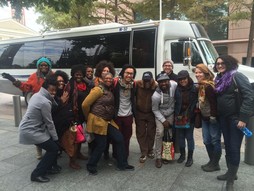 DX team and Dallas partners touring Dallas. Photo by Matthew Cumbie. DX team and Dallas partners touring Dallas. Photo by Matthew Cumbie. Since the 2014 Summer Institute: Stepping Toward Racial Equity, my colleagues at Dance Exchange have been working with artists, historians, and activists in the Dallas-Fort Worth area to create a 10-minute interactive performance, Find the Burning Question Collaborative Movement, and a 90-minute breakout session, Creative Convening: Moving Racial Equity Forward Through the Arts, at the national Race Forward/Dallas Faces Race conference. Here’s more information about the project: Dance Exchange is creating this work in partnership with the newly formed Dallas Faces Race community coalition, Race Forward’s 2014 Facing Race Conference, and The Embrey Family Foundation. This collaboration will amplify groundbreaking social justice work currently being brought to life throughout Dallas in order to connect local resources to local action. Through igniting the power of intergenerational dialogue and action, Dance Exchange and Dallas partners will co-create a performance highlighting the past and present of the Dallas Arts District, which was the site of a Freedman’s Town established during the Reconstruction Era. The purpose of this work is to “leverage the power of the arts towards advancing racial equity in Dallas and beyond. By engaging artists and communities in intergenerational dialogue and creative practices, we are collaboratively building new relationships, unearthing new understandings, and building new avenues for action and change.” In addition to serving as dramaturgy, my colleagues at Dance Exchange have invited me to blog about the creative research we gathered during our time in Dallas. DX team and Dallas partners touring Dallas. Photo by Matthew Cumbie. On Wednesday, November 12, Linda Jones (Dallas based creative partner, journalist, writer, educator, and community advocate), and Don Payton(Dallas based historian) led us on a four hour historical tour of Dallas. Here are the locations and landmarks we visited: Freedmen Memorial Park: the cemetery that honors the lives and burials of more than 5,000 freed men, women, and children. Dallas Arts District, the three remaining buildings of Freedmen’s Town, which was a small community that was formed by men and women freed from slavery in the mid-1860s. St. Paul’s United Methodist Church, cConstruction began in 1901, the church was build brick-by-brick by members and was completed in 1925; Dallas Black Dance - founded in 1976 and housed in the historic Moorland YMCA building; and Booker T. Washington High School – established in 1892 as Dallas’ first school for African Americans. Downtown Dallas: Cattle Drive Sculpture – a somewhat controversial sculpture that celebrates the 19th century cattle drives along the Shawnee Trail; Deep Ellum – one of the first commercial and residential districts for the black community and stomping grounds of legendary blues and jazz artists such as Blind Lemon Jefferson, Huddie “Lead Belly” Ledbetter, and Bessie Smith; and the Knights of Pythias Temple – designed by Dallas’ first African-American architect, William Sidney Pittman (and the son-in-law of Booker T. Washington), the temple served as the social, professional and cultural center of the center of the city’s black community in the early 1900s. South Dallas: African American Museum – started in 1974 , it’s the only museum in the southwestern United States devoted to the preservation and display of African-American artistic, cultural and historical materials and has one of the largest African-American folk art collections in the U.S.; Pan African Connection – home to a vast collection of African arts, fashion, jewelry and books, South Blvd/Park Rd (via MLKing Blvd) – historically black community going through community development and gentrification; Juanita Craft Civil Rights house – it was here where the Montgomery Bus Boycott was planned and Craft was played a central role in integrating University of North Texas and the University of Texas Law School as well as the 1954 Texas State Fair; and many Dallas theaters, restaurants, and lunch counters, and the South Dallas Community Center, 10th St. Historical District: The Bottom – a historic black neighborhood at the bottom of hilly terrain and Benny Walker’s neighborhood junk art display established as part of Activating Vacancy, an initiative designed to stabilize and invigorate the area. We ended our visit at the Dallas Museum of Art. Some folks explored the museum, while others went to rehearse for the Facing Race Opening Ceremony and also to Elaine’s Kitchen for some traditional Caribbean/West Indian cuisine. I met with Ouida to discuss ways to gather creative research and capture our experience over the course of the conference. Over the next few posts, I’ll be sharing more about my experience attending several panel discussions, plenary sessions, and presentations. The lens of my inquiry will be inspired by the following questions, which also guided Dance Exchange in the development of their work:
I look forward to sharing my thoughts, learnings and discoveries with you. 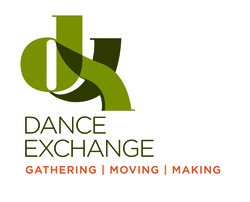 This past summer, I worked with Dance Exchange as part of their annual Summer Institute, which brought together artists, activists from all over the U.S. and Canada. During this 10-day intensive, we guided participants through inquiry, generative dialogue, moving and creative practices that yield strategies for advancing racial equity through the arts. On our first day, we worked with Race Forward Associate Trainers, Tammy Johnson and Nayantara Sen. Race Forward is a national racial justice organization that advances racial justice through research, media and practice. Founded in 1981, Race Forward brings systemic analysis and an innovative approach to complex race issues to help people take effective action toward racial equity. Race Forward publishes the daily news site Colorlines and presents Facing Race, the country’s largest multiracial conference on racial justice. Their interactive training exposed us language concepts and tools for racial justice and equity building. Using movement, hands-on exercise, discussion and application, participants so that we could build on our capacity to address structural racism and implicit bias in the arts. We began our day learning the Key Concepts: Key Concepts- Justice is not Diversity. Diversity is Variety. - Justice is not Equality. Equality is Sameness, and the truth of the matter is we are not the same. We come from radically different cultures, experiences, educational opportunities. - Justice is Equity. Equity means we are treated with fairness and justice. Now, my question is why do we have a wall at all, but this leads us to a conversation about liberation. Only, let's not get ahead of ourselves. We've got to prepare for the revolution first! From there, we defined Racial Justice and Systemic Equity:
This is critical because as we work to dismantle various systems, practices, and ideologies of oppression including, but not limited to racism and sexism, we have to replace them with systems, practices and ideology of Racial and Gender Equity. Individual-Level Racism
Systemic-level Racism
All of what was shared is part of a report, Moving the Race Conversation Forward, by Race Forward: The Center for Racial Justice Innovation that aims to reshape and reform the way we talk about race and racism in our country. The paper includes content analysis of mainstream media (finding two-thirds of race-focused media coverage fails to consider systemic racism), analysis of seven harmful racial discourse practices, and case studies of successful interventions to counteract these trends. This video, produced by Jay Smooth, expands on the report's analysis of media's failure to consider systemic racism. Smooth is the founder of New York's longest running hip-hop radio show, WBAI's Underground Railroad, and Race Forward Video & Multimedia Producer. Moving the Race Conversation ForwardOkay, now that you know how to talk about racism, here are three tips for addressing racism:
Strategies for Addressing Racism at Different Levels
From there, we watched this excellent presentation, Immaculate Perception by Jerry Kang, which helped up to see how explicit and implicit bias works in real life. Makers, Artmakers, Peacemakers: Immaculate perception? "Do you discriminate? UCLA law professor Jerry Kang exposes the phenomenon of automatic processing and how it relates to explicit and implicit bias. Decades of research shows that attitudes and stereotypes influence how we see and behave. Despite our best efforts, are we all under the sway of "the rightness of whiteness?" And is there evidence showing that these biases can be reduced -- at least temporarily? Using humor and audience participation, Kang challenges our assumptions while shifting our perceptions of at least one Asian male." Understanding Implicit Bias and How to Identify and Disrupt ItImplicit Biases are pervasive • People are often unaware of their implicit bias • Implicit biases predict behavior • People differ in levels of implicit bias Implicit Bias is Individual AND Institutional: • A lot of racial inequities occur without intention or malice. It does not require “racists. ” Implicit bias helps explain how racism can be subtle in appearance but significant in impact. • In institutions, the bias of individuals is routinely replicated through collective decisions and actions. It becomes compounded unless it’s consciously counteracted. • “Implicit Bias…offers the idea that discrimination and bias are social, rather than individual issues, and that we can thus all participate in promoting equality.” --American Values Project Implicit Bias and Public Policy • Most policies are facially neutral (race silent) but not racially neutral—they have negative or positive racial impacts. • Negative racial impacts may or may not have been intentional. Positive racial impacts often require intentionality. • When racial impacts are not consciously considered during the lawmaking/decision-making process, there is more likelihood that negative racial impacts will result-- implicit bias is the default. Choice Points • Choice points are decision-making opportunities that influence outcomes. • The cumulative impacts of many small choices can be as significant as the impacts of big decisions. • When we’re conscious of choice points and the related impacts, we’re less likely to replicate implicit bias and the status quo, and we open new possibilities for equitable change. Using Choice Points to Advance Equity
Racial Equity Impact Assessment OverviewWhat are Racial Equity Impact Assessments? A Racial Equity Impact Assessment (REIA) is a systematic examination of how different racial and ethnic groups will likely be affected by a proposed action or decision. REIAs are used to minimize unanticipated adverse consequences in a variety of contexts, including the analysis of proposed policies, institutional practices, programs, plans and budgetary decisions. The REIA can be a vital tool for preventing institutional racism and for identifying new options to remedy long-standing inequities. Why are they needed? REIAs are used to reduce, eliminate and prevent racial discrimination and inequities. The persistence of deep racial disparities and divisions across society is evidence of institutional racism––the routine, often invisible and unintentional, production of inequitable social opportunities and outcomes. When racial equity is not consciously addressed, racial inequality is often unconsciously replicated. When should it be conducted? REIAs are best conducted during the decision-making process, prior to enacting new proposals. They are used to inform decisions, much like environmental impact statements, fiscal impact reports and workplace risk assessments. Racial Equity Impact Assessment GuideBelow are sample questions to use to anticipate, assess and prevent potential adverse consequences of proposed actions on different racial groups. 1. Identifying Stakeholders Which racial/ethnic groups may be most affected by and concerned with the issues related to this proposal? 2. Engaging Stakeholders Have stakeholders from different racial/ethnic groups—especially those most adversely affected—been informed, meaningfully involved and authentically represented in the development of this proposal? Who’s missing and how can they be engaged? 3. Identifying and Documenting Racial Inequities Which racial/ethnic groups are currently most advantaged and most disadvantaged by the issues this proposal seeks to address? How are they affected differently? What quantitative and qualitative evidence of inequality exists? What evidence is missing or needed? 4. Examining the Causes What factors may be producing and perpetuating racial inequities associated with this issue? How did the inequities arise? Are they expanding or narrowing? Does the proposal address root causes? If not, how could it? 5. Clarifying the Purpose What does the proposal seek to accomplish? Will it reduce disparities or discrimination 6. Considering Adverse Impacts What adverse impacts or unintended consequences could result from this policy? Which racial/ethnic groups could be negatively affected? How could adverse impacts be prevented or minimized? 7. Advancing Equitable Impacts What positive impacts on equality and inclusion, if any, could result from this proposal? Which racial/ethnic groups could benefit? Are there further ways to maximize equitable opportunities and impacts? 8. Examining Alternatives or Improvements Are there better ways to reduce racial disparities and advance racial equity? What provisions could be changed or added to ensure positive impacts on racial equity and inclusion? 9. Ensuring Viability and Sustainability Is the proposal realistic, adequately funded, with mechanisms to ensure successful implementation and enforcement. Are there provisions to ensure ongoing data collection, public reporting, stakeholder participation and public accountability? 10. Identifying Success Indicators What are the success indicators and progress benchmarks? How will impacts be documented and evaluated? How will the level, diversity and quality of ongoing stakeholder engagement be assessed? This session was a comprehensive introduction to the Race Forward national conference, which I was fortunate enough to attend and also blog about to capture my experience. My next several post will give you a bit of insight into what I learned there.
|
My BlogI'm a playwright, dramaturg, and teaching artist. It is here where you'll find my queries and musings on life, theater and the world. My posts advocate for diversity, inclusion, and equity in the American Theatre and updates on my own work. Please enjoy!
Categories
All
Archives
June 2020
Reading List
|
